Zuo-Guang. Ye Advanced Dielectric Piezoelectric and Ferroelectric Materials: Synthesis, Characterisation and Applications
Подождите немного. Документ загружается.

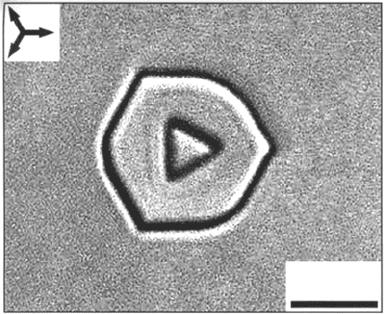
Handbook of dielectric, piezoelectric and ferroelectric materials640
It has been revealed experimentally that the same domain shapes can be
obtained in a wide range of applied fields and the switching times, so the
ratio V
gen
/V
gr
demonstrates non-trivial dependence on the experimental
conditions. According to my general approach the V
gen
/V
gr
ratio is determined
by the screening efficiency, because the role of the residual depolarization
fields increases for ineffective screening.
For incomplete screening the residual depolarization field hampers the
step generation and growth processes. It can be shown that the influence of
the train of uncompensated depolarization field is more pronounced for the
step growth (1D nucleation) along the sides of a polygon as compared with
the step generation (2D nucleation) at the vertices. Thus, under non-equilibrium
conditions (for R >> 1) V
gen
can essentially exceed V
gr
leading to increase of
the step concentration at the wall, which determines the deviation of the wall
orientation from Y directions. Formation of the regular hexagonal domain
shape in LN can be observed only for the equilibrium switching conditions
(for R << 1) with complete screening, when the step concentration is negligible
and the angles at the ‘growing vertices’ are close to 120°. The increase of R
within this approach must lead to increase of the step concentration and to
decrease of the angles at the ‘growing vertices’. In this case the ‘vicinal
walls’ formed essentially deviate from the Y directions imposed by crystal
symmetry.
Based on the above-presented considerations we can state that the shape
of individual domains is determined by domain kinetics which depends on
the switching conditions. The convincing experimental proof of this statement
is presented in Fig. 21.7, demonstrating that it is possible to produce domains
with qualitatively different shapes in the same place on the CLN wafer. The
Y
5µm
21.7
The shapes of domains formed by switching and spontaneous
backswitching in CLN. Switching by short pulse with abrupt edge.
Optical images of domains revealed by etching.
WPNL2204

Nano- and micro-domain engineering 641
domain structure has been produced in single-domain CLN by application of
short rectangular unipolar field pulse with abrupt edge. In this case the new
domains appear within the already switched area as a result of backswitching
after the external field has been switched off (Fig. 21.1e).
The domain structure was revealed by selective chemical etching. The
dark curves on the image correspond to the position of the domain walls. The
large hexagon domain was formed during application of the pulse. The
subsequent backswitching after field switch off leads to formation of triangular
domain in the center of the switched one. The usage of abrupt pulse edge
allows the non-equilibrium conditions for backswitching to be realized.
21.5.2 Domain shape evolution during merging
The domain shape evolution after merging of hexagonal domains was studied
by in situ observation. The most interesting result is the formation of the
strictly oriented X wall after merging of two Y oriented domain walls (Fig.
21.8). The velocity of X wall motion far exceeds the velocity of Y walls. As
a result, the ‘super-mobile’ X wall disappears quickly. The limited lifetime
hinders the direct observation of X wall in the course of the switching
process in the constant field. Nevertheless, switching off the external field
allows the unusual domain polygons with both Y and X walls to be fixed.
According to the above-discussed general approach, the sideways wall
motion velocity is determined by generation rate of the elementary steps.
The abnormally high velocity of the X wall is caused by the maximum
possible density of the elementary steps remaining constant throughout the
lifetime (Fig. 21.8a). The X wall motion velocity is determined by the growth
velocity of elementary steps which reaches meters per second. It is about
1000 times faster than the average sideways Y wall motion velocity in the
same switching conditions. The computer simulation of the domain shape
(a)
(b)
(c)
(d)
(e)
21.8
Schematic drawing of domain shape evolution as a result of
domain merging; (a) formation of
X
wall, (b) two (
Y
) hexagons
before merging, (c) concave (
Y
+
X
) shape, (d) convex (
Y
+
X
) shape,
(e) convex (
Y
) shape.
y
y
WPNL2204
Handbook of dielectric, piezoelectric and ferroelectric materials642
evolution after merging based on the step growth mechanism allowed all
experimentally observed ‘abnormal’ convex polygonal domains with side
numbers ranging from 6 to 12 to be obtained.
The complete evolution of the domain shapes as a result of merging of
two hexagonal domains with Y walls only ((Y)
convex
) (Fig. 21.8b) can be
presented by the following scheme:
(Y)
convex
+ (Y)
convex
→ (Y + X)
concave
→ (Y + X)
convex
→ (Y)
convex
21.7
The concave domain shape (Y + X)
concave
appears just after the merging of
two convex ones (Fig. 21.8c). Such an unusual temporary shape transforms
in a short time to the convex one (Y + X)
convex
due to the fast motion of the
X wall (Fig. 21.8d). At the concave domain stage the length of the X wall
increases. Just after formation of convex domain, the length of the X wall
starts to decrease and then disappears, thus forming the hexagonal domain
with Y walls only (Fig. 21.8e).
The evolution during merging of the regular 2D domain structure produced
by the hexagonal grid electrode pattern has been studied systematically. The
merging of individual domains has been stimulated by artificial conducting
defects between neighboring electrodes. The domain evolution after merging
has been studied in detail both experimentally and by computer simulation
(Fig. 21.9). It has been shown that the shapes of the domain polygons appeared
at different stages of shape evolution are determined by the number and
succession of merging events. The abrupt switching off of the applied field
allows any intermediate domain shape to be stabilized. For example, the
simultaneous merging of three hexagon domains leads to formation of the
regular nonagon (Fig. 21.9a), while consecutive merging of the same domains
results in formation of an octagon (Fig. 21.9b). The understanding of the
origin of abnormal polygon domain shapes can be used to create desirable
domain shapes choosing the proper electrode pattern.
21.5.3 Loss of the domain wall shape stability
The various effects of loss of the domain wall shape stability are observed
for R >> 1, when switching is realized under highly non-equilibrium conditions.
The loss of stability in this case is caused by self-assembled nucleation and
oriented growth of domain rays. The typical finger and dendrite structures
formed due to wall shape instability in LN are presented in Fig. 21.10.
The non-equilibrium switching can be realized experimentally under
different conditions. There are two ways to increase the role of the screening
retardation effect. The first is to accelerate the polarization reversal process
by application of a ‘super-strong’ external field.
WPNL2204
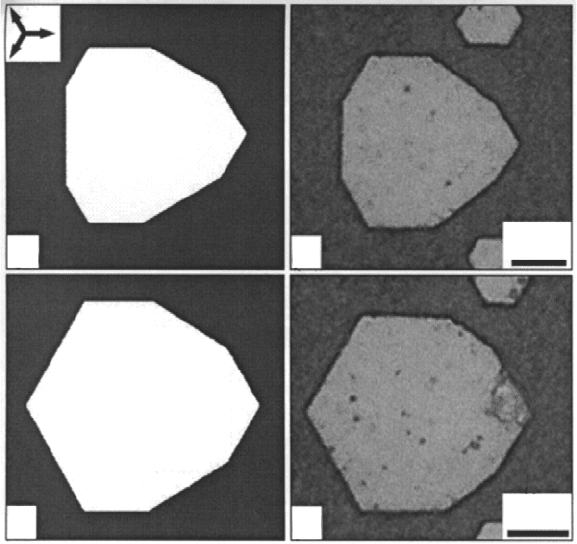
Nano- and micro-domain engineering 643
The second is to increase the input of residual depolarization field by
deposition of the artificial surface dielectric layer. This layer effectively
increases the thickness of the dielectric gap, thus increasing the value of the
residual depolarization field remaining after completion of the fast external
screening. This residual field hampers the motion of the domain wall as a
whole.
This situation is realized during the conventional method of production of
the tailored domain structures in LN and LT by application of electric field
using periodical electrode pattern (Yamada et al., 1993; Webjörn et al.,
1994; Zhu et al., 1995; Myers et al., 1995; Batchko et al., 1999; Rozenman
et al., 1999). The area between the stripe electrodes is covered by photoresist
and domain ‘broadening’ out of the electrodes is frequently accompanied by
the loss of the regular wall shape (Shur, 2005, 2006). Various instabilities of
the domain shape leading to formation of ‘fingers’ (Fig. 21.10a), ‘branches’
and ‘dendrites’ (Fig. 21.10b) were revealed (Shur, 2005, 2006). It must be
stressed that all these self-assembled structures are formed as a result of
Y
(a)
(b)
(c)
(d)
5µm
5µm
21.9
Experimental (right) and simulated (left) domain polygons with
X
and
Y
walls formed as a result of merging of three regular
hexagon domains: (a) nonagon and (b) octagon. Optical images of
domains revealed by etching.
WPNL2204

Handbook of dielectric, piezoelectric and ferroelectric materials644
growth in strictly oriented directions. Such behavior is in accord with the
above-discussed approach.
The uncompensated depolarization field suppresses the broadening of the
strip domains by the sideways motion out of electrodes. Nevertheless, the
alternative mechanism of the broadening through formation of ‘fingers’ can
be observed. The individual finger is a ray oriented along the Y direction,
which has been generated by perturbation at the domain wall. The regular
distribution of the fingers is caused by the electrostatic interaction between
the neighbors.
21.5.4 Dendrite domain structures
The non-equilibrium switching is easily achieved during spontaneous
polarization reversal after abrupt switching off of the external electric field
(backswitching). In this case the retardation of the screening leads to the
existence of strong switching field produced by an uncompensated
depolarization field. The fast backward motion of the wall as a whole terminates
after a small backward shift under the action of appearing residual
depolarization field (Shur, 2005, 2006).
The alternative scenario of the backward wall motion is realized through
the formation and propagation of the quasi-regular structure of fingers strictly
oriented along allowed Y directions, which differ for different sides of the
stripe domain. These two finger structures grow towards each other, but the
electrostatic interaction between approaching fingers prevents their merging
(Shur, 2005). The same effect prevents merging of the neighboring fingers.
As a result, the ‘dendrite-like’ stable structure of residual domains remains
at the end of backswitching (Fig. 21.10b). The complicated shape of individual
fingers is caused by branching. It is seen from detailed analysis of the images
that the branches are also oriented only along allowed Y directions. The
Y
(a)
(b)
5µm5µm
Y
21.10
(a) Finger domain structure formed during periodical poling in
CLN. (b) Dendrite structure formed during backswitching in MgO:LN.
Z
+ view. Black lines show the position of stripe electrode. Optical
images of domains revealed by etching.
WPNL2204
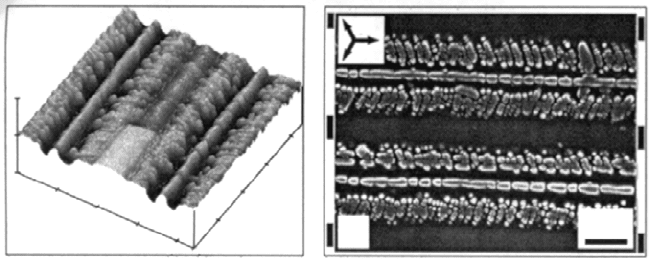
Nano- and micro-domain engineering 645
higher mobility of the front of finger structure as compared with the plane
domain wall is due to the diminishing of the deceleration effect for quasi-
periodic distribution of bound charges (Fatuzzo and Merz, 1967; Lines and
Glass, 1977).
21.6 Self-assembled nanoscale domain structures
The rapid development of the new SPM methods with nanoscale resolution
for visualization of the domain patterns has revolutionized our conception of
the domain kinetics in the case of ineffective screening. A recent study (Shur
et al., 2000a) reveals that along with continuous domain growth (growth of
fingers and dendrites) the discrete switching through the formation of structures
consisting of isolated nanoscale domains can be observed during polarization
reversal at the highly non-equilibrium conditions (R >> 1) (Fig. 21.11). It
has been shown experimentally that the discrete switching through formation
and enlargement of the ensemble of nano-domains occurs in LN. The self-
assembled structures usually demonstrate quasi-regular spatial distribution
of the monomers (isolated nano-domains).
We have discovered the effect of self-maintained spontaneous decay of
the stripe domain structure in CLN through arising and growth of the oriented
nanoscale domain arrays (Batchko et al., 1999; Shur et al., 2000a, 2001,
2003). The domain patterns, revealed by etching and visualized by AFM
(Fig. 21.11a) and SEM (Fig. 21.11b), demonstrate the array-assisted reversal
motion of the existing domain walls through propagation of the highly organized
quasi-periodical structure of domain arrays strictly oriented along
crystallographic directions. Each quasi-regular array is comprised of nano-
domains with a diameter 30–100nm and an average linear density exceeding
Y
(b)
1µm
(a)
1400
nm
1
2
3
4
µm
21.11
Stable nano-domain arrays in CLN formed as a result of
backswitching during periodical poling. Black rectangles – electrode
position.
Z
+ view. Domain patterns revealed by etching and
visualized by (a) AFM and (b) SEM.
WPNL2204
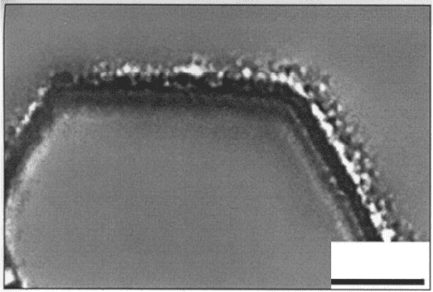
Handbook of dielectric, piezoelectric and ferroelectric materials646
10
4
mm
–1
. Such a domain evolution scenario was observed during switching
using periodical stripe electrodes oriented along the Y-direction deposited on
the Z+-surface. It has been shown that for a sufficient domain spreading out
of the electrodes (obtained for short switching pulse duration ∆t
sp
~ 5ms and
a small field-diminishing amplitude ∆E ~ 2kV/mm) the backswitched domain
evolution represents self-maintained, self-organized growth of oriented
nanoscale domain arrays.
The typical structure produced in CLN covered by artificial dielectric
layer (photoresist) as a result of backswitching after the electric field switch-
off is shown in Fig. 21.10. This domain pattern is stable (frozen-in) and does
not undergo any evident changes for years. According to the optical visualization
with low spatial resolution this structure consists of fingers strictly oriented
along three crystallographic directions similar to the dendrite structures. But
the detailed visualization of these stable domain patterns by SPM reveals
that in this case each finger is an array of nanoscale monomers (Fig. 21.11).
The statistical analysis of the monomer distribution along the array reveals
that the distances between the neighboring monomers are highly correlated.
The effect of correlated nucleation was studied also during switching in
uniform electric field in CLN with surface layer modified by proton exchange.
The in situ recording of the set of instantaneous domain patterns reveals that
the stripe area filled by isolated nanoscale domains propagates in front of the
moving domain wall (Fig. 21.12). The domain growth in this case is achieved
through the appearance of new chains of individual nano-domains in front of
the stripe, while the trailing edge of the stripe is swept by the wall of the
growing solid domain (Shur et al., 2006). It is necessary to point out that in
this experiment the non-equilibrium switching conditions (R >> 1) are fulfilled
100µm
21.12
Propagation of the stripe area filled by isolated nano-scale
domains in front of the moving domain wall during switching in CLN
with proton-exchanged surface layer. Instantaneous optical image.
WPNL2204
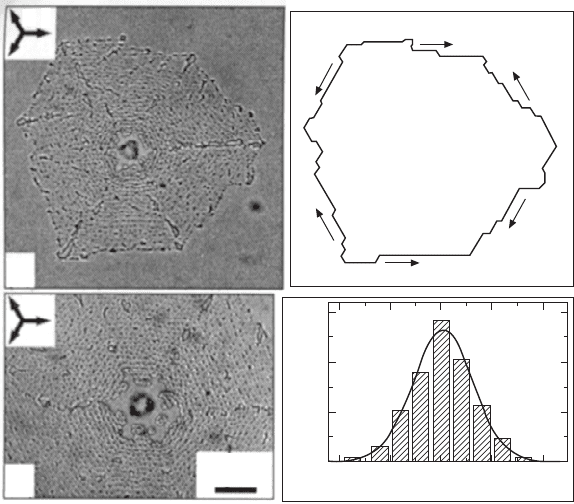
Nano- and micro-domain engineering 647
as the proton exchange leads to the formation of the thick surface dielectric
layer (Shur et al., 2004b).
Another clear demonstration of correlated nucleation effect was observed
for switching in a uniform electric field in SLT completely covered by a
thick artificial dielectric layer (2 µm-thick photoresist) using liquid electrodes
(Shur et al., 2002b; Shur, 2005, 2006). In these conditions the web-like self-
assembled domain structures appear around the pinholes in the dielectric
layer (Fig. 21.13).
The switching process starts as the formation of a ‘hexagon’ domain
around the pinhole. The visualization of the structure by optical microscope
reveals that its subsequent growth is achieved through propagation of the
quasi-regular ensemble of microscale isolated domains. It is possible to
obtain the information about the domain structure evolution by analysis of
the static domain pattern as the positions of the domain chains can be attributed
to the subsequent locations of the ensemble boundary. Such analysis allows
us to conclude that the growth of this structure (evolution of the ensemble
Y
(a)
(c)
Y
15µm
(b)
(d)
Frequency
0.3
0.2
0.1
0.0
0.5 1.0 1.5 2.0 2.5
Distance (µm)
21.13
Web-like self-assembled domain structures formed in SLT
covered by photoresist. (a), (c) Optical images of structures revealed
by etching. (b) Boundary of ensemble of microscale isolated
domains. (d) Distributions function of the distances between the
neighboring domains.
WPNL2204
Handbook of dielectric, piezoelectric and ferroelectric materials648
boundary) follows the same rules as the continuous growth of the isolated
domain. For discrete switching the ensemble boundary shown in
Fig. 21.13b plays the role of the domain wall. The shape of the switched area
is the same regular polygon as in the case of isolated domain growth (see
Section 21.5). The boundaries are oriented in strict crystallographic directions.
One can observe the formation of the steps and their propagation along the
boundary.
The spatial correlation of the individual domain distribution is clearly
demonstrated by statistical analysis of the distances between the neighboring
domains (Fig. 21.13d). The obtained averaged distance between domains is
very close to the thickness of the artificial dielectric gap. This fact opens the
possibility of evaluating the effective depth of the intrinsic dielectric layer
for any material and any experimental condition by measuring the average
period of the quasi-regular structure appearing during discrete switching for
R >> 1.
All the above-discussed self-assembled structures are formed as a result
of correlated nucleation in the vicinity of the moving domain wall or the
propagating boundary of the enlarging domain ensemble. The effect is caused
by the influence on the nucleation probability of the trail of the uncompensated
depolarization field behind the moving wall or propagating boundary. To
explain the effect we have calculated the spatial distribution of the electric
field in the vicinity of the domain wall with the trail in the ferroelectric
capacitor (plate covered by uniform electrodes) with the surface dielectric
layers. It has been shown that the distribution of the field value at the boundary
between the ferroelectric and dielectric layer demonstrates a pronounced
maximum at some distance from the wall (Fig. 21.14a). This distance is
about the thickness of the surface dielectric layer L.
While the field maximum diminishes with the depth (Fig. 21.14),
nevertheless the existence of the field maximum drastically changes the
domain kinetics. On one hand, the trail of uncompensated depolarization
field suppresses the nucleation at the wall, thus terminating the classical wall
motion. On the other hand, it induces the field maximum, which increases
the probability of nucleation at the definite distance in front of the wall. The
growth of nuclei leads to the appearance along the wall of the isolated
needle-like micro-domains with charged walls. The sideways growth of any
isolated domains that arise is suppressed due to the same effect of the
uncompensated depolarization field. The decrease of the local electric field
in the vicinity of each isolated domain initiates the formation of new domains
at some distance from each other. As a result, the quasi-regular domain chain
aligns along the wall.
It has been calculated that the new field maximum appears at the distance
from the formed domain chain thus initiating formation of the new chain,
leading to self-maintained enlarging of the domain ensemble. It has been
WPNL2204
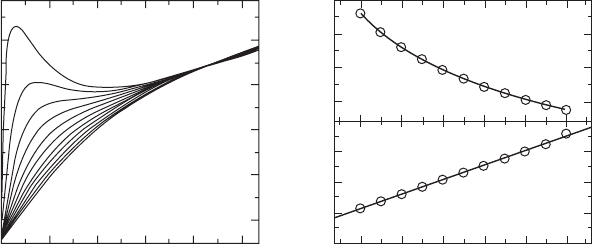
Nano- and micro-domain engineering 649
shown experimentally that these self-assembled structures can cover areas of
several square millimeters.
There are two ways to intensify the role of the correlated nucleation
process. One of them has been realized by increasing the ratio R, by
amplification of the switching field or by hindering the screening processes.
This possibility has been demonstrated in the above-discussed backswitching
experiments. The alternative possibility is the deposition of the artificial
surface dielectric layer, thus increasing the residual depolarization field. The
period of the quasi-regular structure increases accordingly in this case.
21.7 Modern tricks in nanoscale domain engineering
21.7.1 Backswitch poling
The backswitching process is always considered as undesirable one, because
it destroys the tailored domain structure, but its detailed study is useful. An
original poling method for creation of short-pitch periodical domain structures
in LN and LT, so-called ‘backswitched poling’, has been proposed (Batchko
et al., 1999, 2003; Shur et al., 2000a). The unique feature of backswitched
poling is that the polarization reversal occurs without application of any
external electric field. The domain kinetics is induced by internal source –
residual depolarization field existing after abrupt switch-off of the external
field due to retardation of the bulk screening.
Two distinguishable stages of domain evolution can be revealed during
backswitched poling (Fig. 21.15). The process starts with nucleation of chains
Local field
–2
–3
–4
–5
–6
Depth from 0.1L to 3.9L
0246810
Distance from domain wall
E
max
–2.0
–2.5
–3.0
1.5
1.0
0.5
0.0
∆
X
max
(a)
(b)
(c)
0.1 0.2 0.3 0.4 0.5 0.6
Depth
21.14
(a) The simulated local field distributions near the stripe non-
through domain for different depth under the dielectric surface layer.
Depth dependences of (b) value of local field maximum
E
max
, (c)
distance between the wall and field maximum ∆
x
max
. The distance
from the domain wall and depth are normalized by the thickness of
the surface dielectric layer
L
.
WPNL2204
